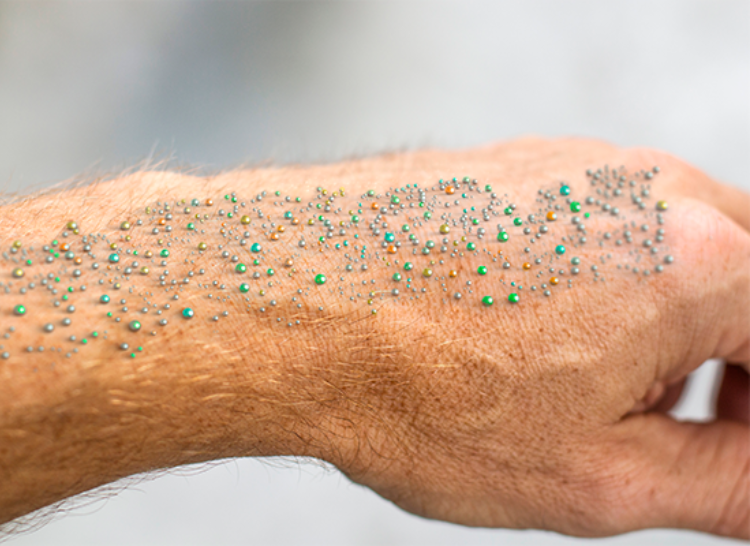ALBA Synchrotron

A research project led by the University of Porto in collaboration with the ALBA Synchrotron has studied for the first time the interaction of nanoparticles with the skin, using synchrotron light at the MIRAS beamline. The findings unveil the role of the different skin components and the mechanism of the permeation enhancement conferred with nanoparticles, made from marine polymers. A nano delivery system application in the skin will reduce the dosage needed due to controlled drug delivery and allow newer and better-targeting therapeutic strategies towards cutaneous administration.
Cutaneous drug delivery allows the administration of therapeutic and cosmetic agents through the skin. Advantages of this administration route include high patient compliance, avoidance of high concentration levels of the drug when reaching systemic circulation, and far fewer side effects compared to other administration routes.
Still, the peculiar skin structure assures protection to the human organism and hampers drug delivery. To overcome this issue, skin permeation enhancers, such as nanoparticles, can be used. They are pharmacologically inactive molecules that can increase skin permeability by interacting with the stratum corneum, the first layer of the epidermis, which is the outermost layer of the skin. However, the mechanisms of nanoparticles’ interaction with the skin structure are still unknown.
A research led by the University of Porto (Portugal) in collaboration with the ALBA Synchrotron has studied for the first time the interaction of polymeric nanoparticles with the skin, using synchrotron light.
The nanoparticles used are made of fucoidan and chitosan, marine polymers that are biocompatible and biodegradable, as well as naturally abundant and low-cost. Fucoidan is obtained from brown seaweeds and chitosan is derived from the shells of shrimp and other crustaceans.
The findings described in this work have contributed to unveiling the role of the different skin components and the possible mechanism of the permeation enhancement conferred with the studied nanoparticles.
Application of a nano delivery system in the skin will reduce dosage applications due to controlled drug delivery and allow newer and better-targeting therapeutic strategies towards cutaneous administration.
The Synchrotron-based Fourier Transform Infrared Microspectroscopy at the MIRAS beamline of ALBA is a non-invasive and powerful technique for the characterization of the skin at a molecular level. It allows the analysis of composition and conformational changes in molecules such as proteins, lipids, carbohydrates and nucleic acids.
Comparing the action of different polymers with synchrotron light
In this work, researchers compared the permeation enhancement mechanism of nanoparticles produced using chitosan of low-molecular weight and medium-molecular weight. This is because molecular weight has been reported to influence the physical properties of chitosan. A polymer's molecular weight indicates the average length of the many repeating subunits – chains - that form the polymer.
Results showed that low-molecular weight chitosan nanoparticles proved to be more suitable for skin local treatment, since they are more stable at skin pH value, which is lower than the physiological pH. On the other hand, medium-molecular weight chitosan nanoparticles remain stable at skin and physiological pH values, so they are suitable for both local and systemic treatments.
Additionally, the team conducted in vitro skin permeation assays to fully assess the marine polymers nanoparticles role as permeation enhancers. The scientists “filled up” the nanoparticles with calcein used as a drug model. Calcein is a hydrophilic molecule, which means it is “water-loving” and “lipid-fearing”, so the encapsulation within the polymeric nanoparticles should help it travel easier through the lipids that form the skin. Results demonstrated that both low- and medium-molecular weight chitosan nanoparticles improved calcein’s diffusion throughout the skin. This proves the enhancer properties of these marine polymeric nanoparticles.
Synchrotron experiments showed that low-molecular weight chitosan nanoparticles lead to skin lipid disorganization while medium-molecular weight chitosan nanoparticles interact with protein structure. Thus, given chitosan’s molecular weight, the nanoparticle-skin interaction are distinct but the permeation outcome is similar. In sum, data suggest that both types of nanoparticles act as enhancers in calcein skin permeation.

Figure. Graphical abstract. Left inset features the infrared spectra of the skin within the protein’s spectral region and the contributions of amide I and amide II bands for the stratum corneum. Right inset shows the evaluation of the lipid CH2 stretching region of the skin for stratum corneum. Samples treated with water - control (blue), F/CM nanoparticles (red) and F/CL nanoparticles (green).
With the collaboration of Fundación Española para la Ciencia y la Tecnología. The ALBA Synchrotron is part of the of the of the FECYT and has received support through the FCT-21-17088 project.